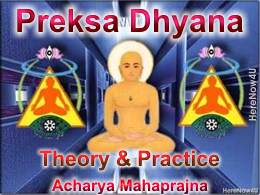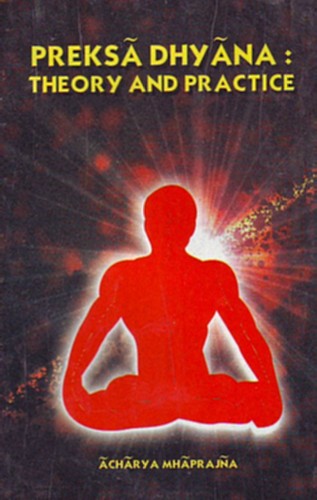
The word Preksa is derived from the root ‘iksa’, which means 'to see'. When the prefix 'pra' is added, it becomes pra + iksa = preksa, which means to 'perceive carefully and profoundly.'
Here, 'seeing' does not mean external vision, but careful concentration on subtle consciousness by mental insight. Preksa dhyana is a system of meditation engaging one's mind fully in the perception of subtle internal and innate phenomena of consciousness.
Sampikkhae appagamappaenam (Skt. Samprekseta atmanamatmana)
This aphorism from the Jaina canon Dasavealiyam forms the basic principle for this system of meditation. It simply means: 'See you thyself' - Perceive and realize the most subtle aspects of consciousness by your conscious mind. Hence, "to see" is the fundamental principle of meditation. The name preksa dhyana was therefore assigned to this system; thus this technique is basically not concentration of 'thought' but concentration of 'perception'.
The terms dhyana (meditation) is usually defined as the 'concentration of thinking on a particular subject for a length of time. Now, the mind is the instrument of 'thinking', as well as 'perception'. And, therefore, when linked with 'preksa', dhyana becomes 'concentration of perception and not of thought'. While it is conceded that both thinking (conception) as well as seeing (perception) assist in ascertaining and knowing the truth, the latter is more potent than the former. In the tenets propounded by Bhagavan Mahavira, 'Perceive and know’ is given more prominence than 'Think, contemplate and know'. This is because perception is strictly concerned with the phenomena of the present; it is neither a memory of the past nor an imagination of the future; whatever is happening at the moment of perception must necessarily be a reality. The process of perception, therefore, excludes a mere 'appearance'.
One commences the practice of this technique with the perception of the body. The body contains the soul. Therefore, one must pierce the wall of the container to reach the content (the soul). Again, 'breathing' is a part of the body and the essence of life. To breathe is to live: and so breath is naturally qualified to be the first object of our perception, while the body itself would become the next one. Our conscious mind becomes sharpened to perceive the internal realities in due course, and then it will be able to focus itself on the minutest and the subtlest occurrences within the body. The direct perception of emotions, urges and other psychological events will then be possible. And ultimately, the entire envelope of karmic matter, contaminating the consciousness, could be clearly recognised.
As stated above, our conscious mind is capable of two categories of functions viz. thinking and perceiving - conception and perception. But it is incapable of being engaged in both the categories simultaneously. One either thinks or perceives. Exclusive perception of a single object' can thus become an efficient tool for steadying the ever-wandering mind. If one concentrates in perceiving any external object, he finds that his mind has steadied and his train of thoughts has almost halted. Similarly when one concentrates on the perception of his own internal phenomena such as sensations, vibrations or even thoughts, he will realize that the mind has stopped its usual meandering and is fully engaged in perception.
In preksa, perception always means experience devoid of the duality of like and dislike. When the experience is contaminated with pleasure and pain, like and dislike, perception loses its primary position.
 Acharya Mahaprajna
Acharya Mahaprajna

